Would you like to know how to create an SEO content strategy that boosts your search rankings?
Search engine optimization (SEO) is a strategic digital marketing tactic that requires careful planning and execution. Otherwise, your efforts won’t have any impact, leading to a waste of resources and time.
In this article, we’ll show you how to craft an SEO strategy that boosts rankings, drives relevant traffic, and contributes to business growth.
In This Article
- What is an SEO Content Strategy?
- 9 Tips for Creating an Impactful SEO Content Strategy
- 1. Invest in the Right SEO Tool
- 2. Know Your Target Audience
- 3. Pinpoint Intent-focused Keywords
- 4. Establish Your Priority Content Types
- 5. Include Topic Clusters for Authority Building
- 6. Have an On-page SEO Strategy
- 7. Have a Way to Ensure Your Pages are Indexed
- 8. Be Strategic About Distribution
- 9. Monitor Your SEO Performance
- How to Create an SEO Content Strategy: Your FAQs Answered
- Improve Your Rankings and Visibility with an Impactful SEO Content Strategy
What is an SEO Content Strategy?
An SEO (Search Engine Optimization) content strategy is a plan or approach designed to optimize the content on a website for search engines. The goal is to improve the website’s visibility in search engine results pages (SERPs) for relevant keywords and phrases. A well-executed SEO content strategy can attract more organic traffic to a website, enhance its online presence, and ultimately drive business goals.
Why is an SEO Content Strategy Important?
An SEO content strategy is important because it enhances your site’s visibility in search engines. It also helps contribute to a positive user experience (UX), credibility, and long-term business success. This is because it’s an essential tool that:
- Ensures you’re targeting the right keywords
- Creating impactful content
- You’re consistent in your content production
- Your content distribution is effective
An SEO content strategy is a fundamental aspect of digital marketing that you should strongly consider integrating into your broader marketing efforts for maximum impact.
9 Tips for Creating an Impactful SEO Content Strategy
1. Invest in the Right SEO Tool
One of the first steps to developing an impactful SEO content strategy is investing in the right SEO tool. And for WordPress users, there’s no better tool than All In One SEO (AIOSEO).
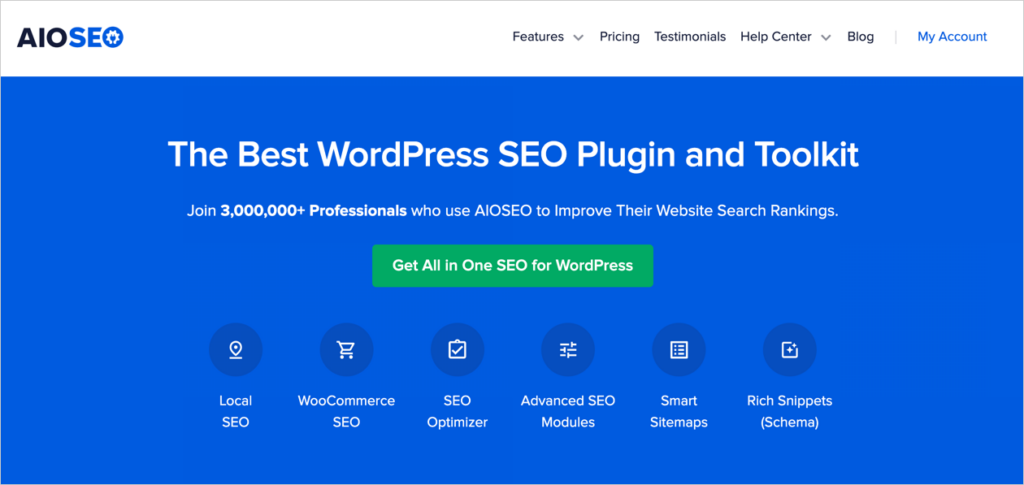
AIOSEO is a powerful yet easy-to-use SEO plugin that boasts over 3 million active installs. Millions of smart bloggers use AIOSEO to help them boost their search engine rankings and drive qualified traffic to their blogs. That’s because the plugin has many powerful features and modules designed to help you properly configure your SEO settings. Examples include:
- Cornerstone Content: Easily build topic clusters and enhance your topical authority and semantic SEO strategy.
- SEO Revisions: Track any changes you make to your site and see their impact on your SEO. Plus, you get to see on a timeline how Google updates affect your site.
- Advanced Robots.txt Generator: Easily generate and customize your robots.txt file for better crawling and indexing.
- TruSEO Highlighter: Makes it easy to spot on-page SEO issues and gives recommendations for fixing them.
- Next-gen Schema generator: This no-code schema generator enables users to generate and output any schema markup on your site.
- Redirection Manager: Helps you manage redirects and eliminate 404 errors, making it easier for search engines to crawl and index your site.
- Link Assistant: Powerful internal linking tool that automates building links between pages on your site. It also gives you an audit of outbound links.
- SEO Preview: This gives you an overview of your search and social snippets and general SEO so you can improve your optimization.
- IndexNow: For fast indexing on search engines that support the IndexNow protocol (like Bing and Yandex).
- Sitemap generator: Automatically generate different types of sitemaps to notify all search engines of any updates on your site.
- And more
AIOSEO also has many other features to help you boost your local SEO, on-page SEO, and technical SEO.
For step-by-step instructions on how to install AIOSEO, check our detailed installation guide.
2. Know Your Target Audience
Many marketers and SEOs make the mistake of optimizing content for search engines only. That’s not what SEO content is about. Genuine SEO content also considers the target audience.
That’s why you must include audience research when developing your SEO content strategy. This includes thinking about:
- Who is your intended audience?
- What problems are they likely to have?
- What solutions are they looking for?
- Do they have a particular way of speaking (lingo)?
Answering these questions will give you the foundation you need to conduct impactful keyword research. It also helps you create personalized content, making your audience trust you more. It also helps boost your conversion rates and increases the chances of it being shared.
By tailoring your content to address the needs and interests of your audience, you ensure that it ranks well and satisfies your audience.
Learn more in How to Create a Customer-Centric Content Strategy that Converts.
3. Pinpoint Intent-focused Keywords
Keyword research is a foundational aspect of creating SEO content. It involves understanding the words, phrases, and questions your target audience input in browsers like Google when searching for information. Keyword research also involves strategic tasks like checking keyword difficulty and whether targeting those keywords is feasible.
While keyword research may sound like a daunting task, it’s fairly easy with the right keyword research tool. Great examples include Semrush, Ahrefs, Google Keyword Planner, and more. Also, focusing on long-tail keywords is a great way to capture more specific search queries. Plus, long-tail keywords have low competition, giving you better chances of ranking.
Besides keyword research, you also need to understand search intent. Search intent refers to the reason behind a user’s search query. While it may sound complicated, figuring out search intent is quite easy. Two of the best ways to do it are:
- Using tools: keyword research tools like Semrush have a search intent feature that helps highlight the most common user intent behind a keyword.
- Studying SERPs: Study the SERPs and see the type of content that ranks well.
Understanding search intent is important as it helps you create SEO content that satisfies your target audience’s search queries. As a result, it will convert better.
So, if you want to craft a winning SEO content strategy, you must pinpoint intent-focused keywords that will help you drive relevant traffic to your site.
Explore.com, a travel and tourism site, used the SEO strategy of targeting long-tail keywords. The long-tail keywords they targeted had a very specific purpose for fulfilling the user search intent. And it’s not a surprise they quadrupled their traffic in 10 Months. Read how Explore.com grew in 10 months.
4. Establish Your Priority Content Types
Another important element of an impactful SEO content strategy is establishing your most important content types. These are the content formats your target audience prefers. They should also be content formats that support your business model. Some of the most common content types include:
- Blog posts
- Videos
- Infographics
- Podcasts
- Case studies
- Ebooks
- Product reviews
These content types serve different purposes and cater to diverse preferences among audiences. A well-rounded content strategy often incorporates a mix of these formats to reach and engage a broader audience.
5. Include Topic Clusters for Authority Building
The concept of topic clusters involves creating a pillar or cornerstone piece of content around a core topic and then building a cluster of related content around it. This helps build topical authority and enhance your semantic SEO, both great ways of getting your site and content to rank in a competitive niche.
This strategy also enhances the overall effectiveness of your SEO content strategy by improving content relevance, user experience, and search engine visibility. An added benefit of creating topic clusters is that they provide a strategic framework for creating and organizing content to meet the evolving demands of both users and search engines.
Creating a topic cluster requires 2 main components:
Cornerstone Content (Pillar Page)
Your cornerstone content is the hub of the topic cluster. This page covers the main subject in-depth, with each subheading briefly addressing related subtopics.
You can easily mark these using AIOSEO’s revolutionary Cornerstone Content feature:
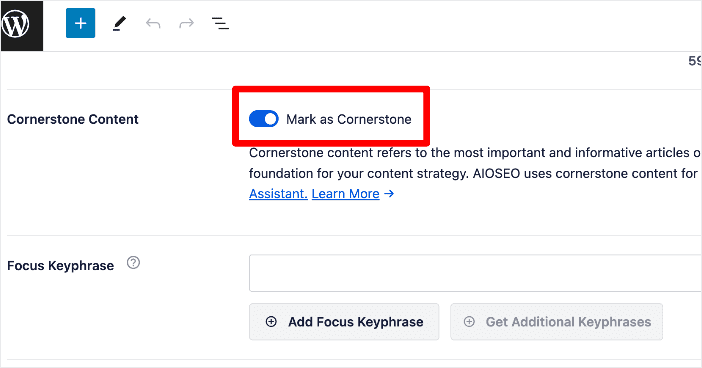
Marking your post or page as cornerstone content also adds it to a new post list filter dedicated to cornerstone content.

This filter allows you to see your important pages at a glance, making it easier to create links to them.
Subtopic Pages
Subtopic pages are the posts you create to provide in-depth coverage of a single aspect of the main subject and link to the pillar page.
Once you’ve built your pillar pages and subtopics, create strategic internal links between them. Don’t worry. This is super easy, as AIOSEO’s Link Assistant module automates this process for you. And identifying your cornerstone content is also easy, as it’s denoted by a building icon.
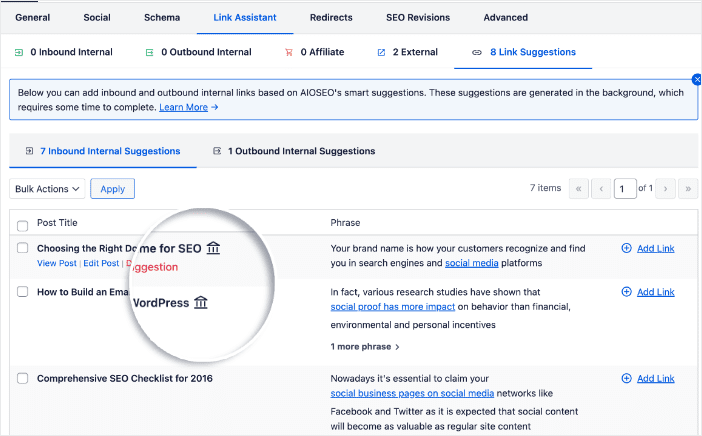
Click the Add Link button to add links to your cornerstone content, and Link Assistant will work its magic in the background. You don’t even have to open the pages in editor mode!
Check out our tutorial for detailed instructions on using the Cornerstone Content feature in AIOSEO.
6. Have an On-page SEO Strategy
Your SEO content strategy can’t be complete without a well-defined on-page SEO strategy. On-page SEO refers to all the optimizations you can make directly on your site, posts, or pages. This includes elements such as:
- Keyword research and usage
- Proper use and optimization of header tags
- Internal linking
- Meta tag optimization (Title tags and meta descriptions)
- Well-written copy that meets Google’s E-E-A-T standards
- Image optimization
- Schema markup
- And more
Because there are so many boxes to tick, it’s best to rely on on-page SEO tools to help with this. You should also use an on-page SEO checklist to ensure you’ve covered all your bases.
7. Have a Way to Ensure Your Pages are Indexed
Another essential element to add to your SEO content strategy is ensuring that search engines index your posts and pages.
Indexing refers to the process search engines use to store information about your web pages in their database. This makes it easy for them to pull up your content for relevant search queries and present them to users on SERPs.
If your website isn’t in Google’s index, your content won’t be discoverable on search engines. That’s why it’s critical to make sure your site is indexed. Don’t worry, though. You can easily check your index status right inside your WordPress dashboard using AIOSEO’s Index Status feature.
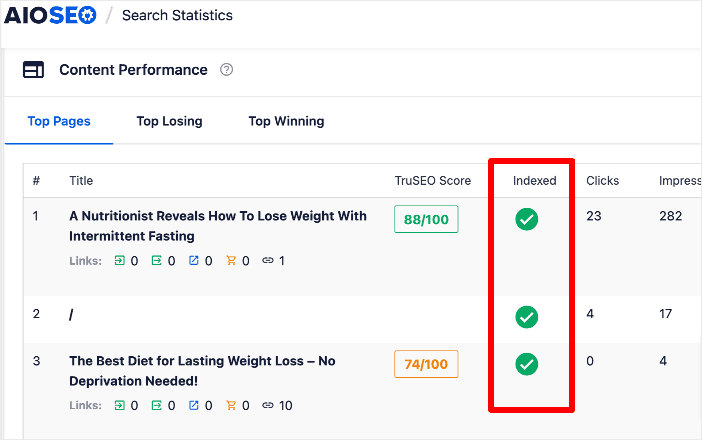
For improved indexing, check out our top tips for indexing your site faster on Google.
8. Be Strategic About Distribution
Content distribution refers to the strategic promotion and sharing of content across various online channels. This helps maximize your content’s reach, visibility, and impact. The goal of content distribution is to ensure that your content reaches the right audience in the right places at the right time. This helps foster engagement, increase brand awareness, provide backlink opportunities, and, ultimately, achieve your marketing objectives.
For your content distribution to be effective, focus on the channels and platforms your target audience spends the most time on. Examples of the channels you can target include:
- Your website
- Third-party websites (business listings, guest posting, or review sites)
- Social media platforms
- Content syndication platforms
Your target audience determines your content distribution channel of choice. You’ll want to distribute your content where they hang out.
9. Monitor Your SEO Performance
Monitoring the performance of your content is a crucial aspect of running an impactful SEO content strategy. If you’re a WordPress user, you can easily do this using AIOSEO’s Search Statistics module.
Search Statistics is a powerful Google Search Console (GSC) integration that lets you track your keyword rankings, content performance, and other important SEO metrics with 1-click. That’s because it comes with many reports for monitoring SEO performance.
There are 4 ways you can use Search Statistics to monitor SEO performance:
1. Monitoring Your Overall SEO Metrics
Checking the performance of your SEO content in WordPress is super easy. To do so, head over to Search Statistics in the AIOSEO menu. Clicking on this leads you to the Search Statistics Dashboard.
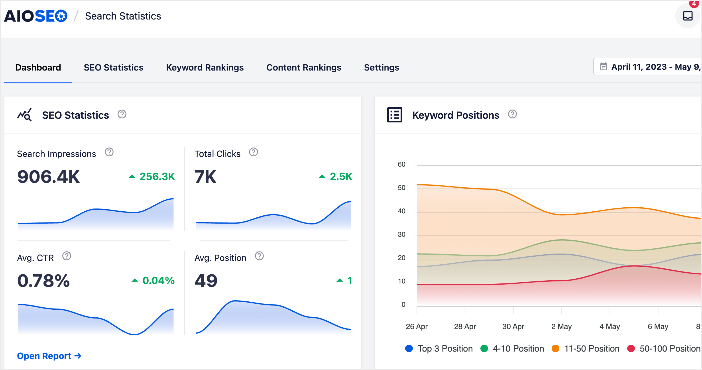
The Dashboard section will give you an overview of important SEO metrics like Search Impressions, Total Clicks, Average CTR, and Average Position. It also shows you an overview of the number of keywords ranking at different positions. You can see this in the Keyword Positions section.
The Keyword Positions graph gives you an overview of how your content is performing.
Besides the overview on the dashboard, there are two other reports that can help you check your search visibility. These are the Keyword Ranking report and the Content Performance report.
2. Using the Content Performance Report
AIOSEO’s Search Statistics module comes with a Content Performance report that shows you how your posts and pages are performing on SERPs. To access it, go to AIOSEO » Search Statistics » SEO Statistics. Next, scroll down to the Content Performance report.
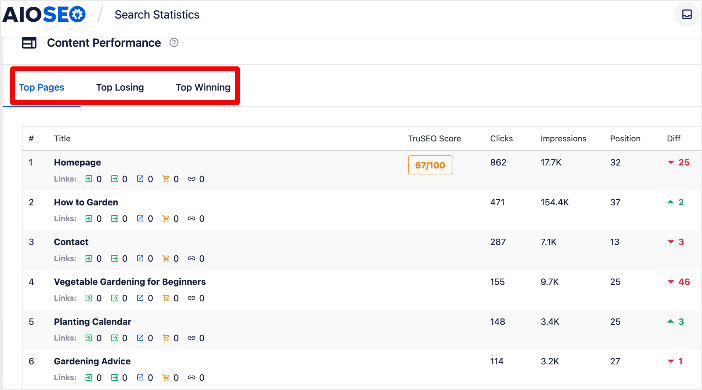
The Content Performance report shows you 3 main content metrics, namely:
- Top Pages: This shows you your best-performing pages.
- Top Losing: This shows the pages losing rankings the most.
- Top Winning: This shows the content that’s gaining higher rankings.
The Content Performance report gives you key metrics like Clicks, Impressions, Position, and Diff (change in position) for each page in this report. These give you deep insights into what’s happening to your content on SERPs.
Regarding the performance of your SEO content, the 2 most important metrics are Position and Diff. The positions tab shows you the position each page holds on SERPs, while the Diff shows whether your content is improving in performance or decaying.
3. Using the Keyword Rankings Report
The Keyword Rankings report gives you great insights into how your content is performing for your target keywords. You can check this report by going to AIOSEO » Search Statistics » Keyword Rankings.
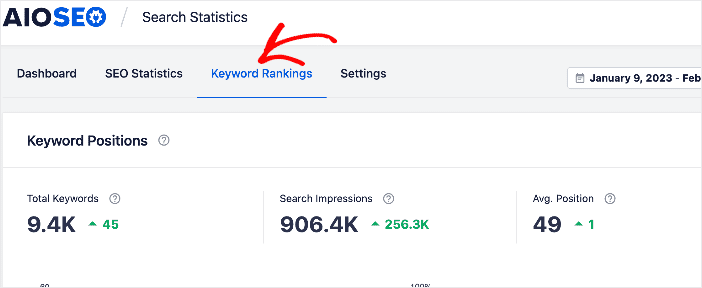
This is where you get a detailed report of all your keywords and their performance on SERPs. The report shows vital information like the Total Keywords you’re ranking for, Search Impressions, and Average Position. These metrics give you a general overview of your rankings and online reach.
To get a more granular view of your performance for specific keywords, scroll down to the Keyword Performance section.

Essential metrics for each keyword include Clicks, Average CTR, Impressions, Position, and Diff.
The tab to keep an eye out for as you monitor the performance of your SEO content is the positions tab. It gives you the SERP position of your keywords, enabling you to see how well you’re ranking for it.
4. Monitor Content Decay
You can also use Search Statistics to monitor content decay. This is the gradual decrease in organic performance for content designed specifically for SEO.
Because it’s not easily detectable, content decay is a silent killer of SEO performance, making it difficult for you to maintain an upward trajectory on SERPs. As a result, your organic traffic and revenue can decline.
That’s why combatting content decay should also be an integral part of your SEO content strategy.
To monitor content decay, head to the Content Performance tab in Search Statistics to see which articles are performing well and which are losing rankings.

Once you discover your decaying content, stopping it, improving your rankings, and boosting your organic traffic is easy.
Check out our tutorial on stopping content decay for detailed steps on monitoring and combating content decay.
How to Create an SEO Content Strategy: Your FAQs Answered
What is an SEO content strategy?
An SEO content strategy is a plan that outlines the creation and optimization of content to improve a website’s visibility in search engine results. It involves keyword research, content creation, on-page optimization, and other tactics to attract organic traffic.
Why is an SEO content strategy important?
An SEO content strategy is essential for improving a website’s search engine rankings, increasing visibility, attracting targeted traffic, and achieving business goals. It helps create high-quality, relevant content that satisfies user intent and aligns with search engine algorithms.
How can I measure the success of my SEO content strategy?
WordPress users can measure the success of their SEO content strategy using AIOSEO’s Search Statistics feature. This gives you Google Search Console (GSC) data right inside your WordPress dashboard. You can also use analytics tools like Google Analytics or MonsterInsights to monitor key metrics.
Improve Your Rankings and Visibility with an Impactful SEO Content Strategy
An SEO content strategy is an essential ingredient for ensuring that your content marketing efforts produce results. Having one increases your chances of ranking high, driving relevant traffic, and growing your business.
We hope this post has helped you know how to create an impactful SEO content strategy. You may also want to check out other articles on our blog, like our beginners’ guide to SEO or our ultimate WordPress SEO checklist.
If you found this article helpful, then please subscribe to our YouTube Channel. You’ll find many more helpful tutorials there. You can also follow us on X (Twitter), LinkedIn, or Facebook to stay in the loop.
Disclosure: Our content is reader-supported. This means if you click on some of our links, then we may earn a commission. We only recommend products that we believe will add value to our readers.
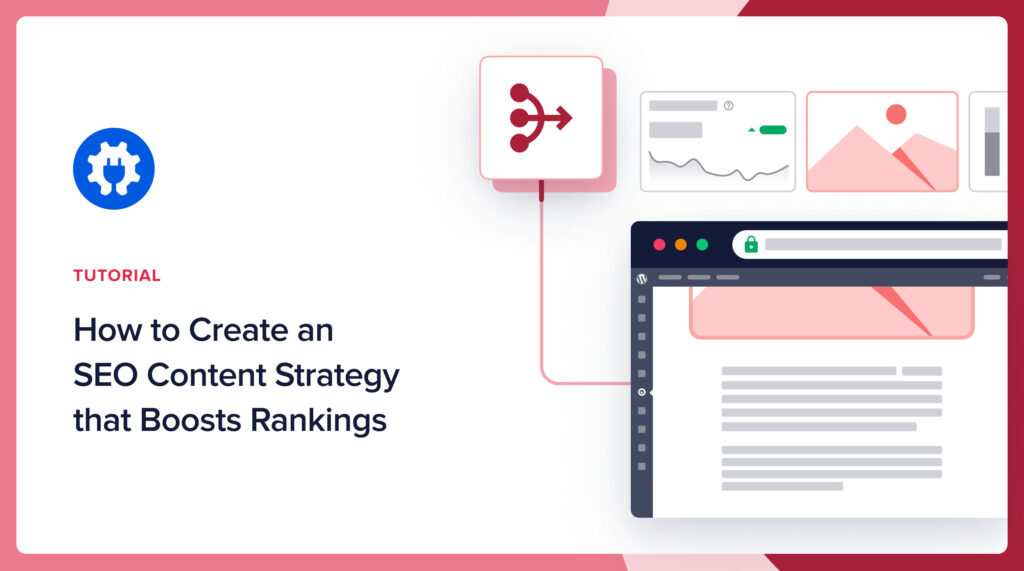

My good page